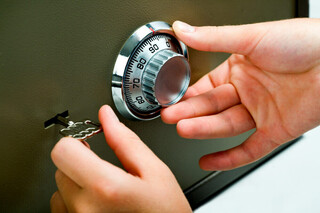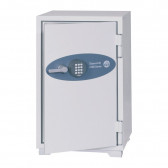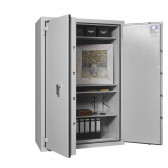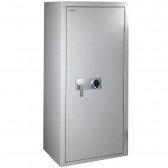The basic function of a lock is to protect the contents of a safe from falling into the wrong hands. Are you looking for a secure and effective solution, perhaps a lock that is easy to operate, or perhaps you are looking for value for money? Find out what the market has to offer and choose a security solution tailored to your individual needs.
Key lock
As standard equipment for a safe, you will usually receive a double-bit key lock. This is a basic and easy-to-use solution when price is your primary selection criterion. Simply turn the key and the handle to open or close the safe door. In addition, key locks are characterised by their robustness and low failure rate. However, they also have their disadvantages. Despite the fact that lock manufacturers use advanced methods to produce keys, there is a risk of forgery. Keys therefore need to be protected from falling into the wrong hands, and from being lost or stolen. It is also difficult to store the key safely. This is due to its size. The key length is about 10 cm, but in safes with thicker doors, the key length can exceed 15 cm. The key can be damaged or broken and is difficult to carry around.
As a standard, two keys are issued for the lock. If a key is damaged (e.g. one of the teeth breaks), you can have a duplicate made by the manufacturer. If one of the keys is lost or stolen, the lock must be replaced for safety reasons. If both keys are lost, the only alternative is to open the safe mechanically.
Mechanical combination lock
More and more frequently safes appear in our houses or flats. Mechanical combination locks can be recommended for home safes. This type of lock will work especially well if you intend to use the safe occasionally. Why?
A mechanical combination lock does not need mains power or batteries, which is its main advantage. To open the safe, you need to use the dial on which the lock settings are located and then enter the code, which consists of several combinations of numbers predefined by the manufacturer. To set a new code, remember to always perform all the operations indicated in the lock's instruction manual with the safe's door open, as making a mistake will not lock the safe in the closed position.
It is absolutely necessary not to leave the factory code in a mechanical combination lock. This could result in unauthorised persons or a burglar gaining access to the contents stored in the safe. You will need to memorise the code and learn to accurately enter the settings on the dial – which may be an inconvenience for some potential users.

Electronic combination lock
The most frequently chosen by professionals, but increasingly also by private customers, is the electronic code lock. In comparison with the previously described mechanical code lock, it requires battery power supply. When the battery charge level is low, an appropriate information appears on the display, an acoustic signal sounds or it is signalled by diodes which start blinking or lighting up as described in the instruction manual.
An electronic lock is a practical solution if you intend to use the safe frequently as it allows quick opening and access to the deposited contents. The more advanced models of electronic combination locks allow more users to be programmed and are equipped with an audit function, i.e. a record and the possibility of replaying a certain number of recent operations. The latter is useful if you intend to make the safe available to company personnel, but want to maintain control over user rights. You can also integrate an electronic lock with an alarm system, for example in your company's premises, which means a much higher level of security.
As with a mechanical combination lock, you need a few-digit code to open it, which you enter on the keypad. The factory-defined code must be changed to an individual code known only to the safe's user immediately after purchase. As with a mechanical combination lock, this must be done with the safe door open.
Another article will tell you what is important when changing the cipher: Changing the code on your safe. 5 facts you need to know.
Biometric lock
Technological progress has meant that special types of electronic locks with a built-in fingerprint reader are also available on the market, used by both private customers and professionals. This is a lock for those who value uncompromising, individual solutions and top quality.
The modern solution is easy to use. After purchasing the safe, the user's fingerprint needs to be programmed, and to open the safe it is enough to put the finger to the fingerprint scanner, or alternatively run over it. It is important that when using the biometric lock, hands are clean and the print is free of injuries or scars. This is because even minor dirt or damage to the fingerprint can make it difficult to identify the user.
Find out more: How does a safe lock with a fingerprint reader work?
Summary
There are also combinations of locks used – for example a key with an electronic or combination lock. These models are characterized by an even better level of security, because they allow the safe to be opened by, for example, two people, each of whom has access to only one of the locks, but it is a more expensive solution.
The general rule when using mechanical combination locks and electronic locks is not to write down the code and not to place it right next to the safe or in a place considered by us – even potentially – as safe. This can have serious consequences.
Read also: What about safes can you learn from Grzegorz Miecugow's book titled "Coincidence"?
As you can see, choosing a lock doesn't have to be difficult, and its type depends entirely on your individual needs and preferences. However, if you are still hesitating on what purchase decision to make, want to buy a safe or have any additional questions – feel free to contact us.





